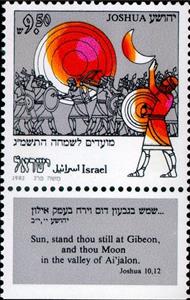Stamp with Collectible Margin: Joshua Stops the Sun (Israel 1982)
Joshua Stops the Sun (Israel 1982)
10 August (Israel ) within release Festival 1982 goes into circulation Stamp with Collectible Margin Joshua Stops the Sun face value 9.50 Israeli sheqel
| Stamp with Collectible Margin Joshua Stops the Sun in catalogues | |
|---|---|
| Michel: | Mi: IL 889T |
| Stamp Number: | Sn: IL 823T |
| Yvert et Tellier: | Yt: IL 832T |
| Stanley Gibbons: | Sg: IL 863T |
Stamp with Collectible Margin is square format.
Also in the issue Festival 1982:
- Stamp with Collectible Margin - Blowing Down the Walls of Jericho face value 7.50;
- Stamp with Collectible Margin - Crossing River Jordan face value 5.50;
- Stamp with Collectible Margin - Joshua and Israelites setting out for Canaan face value 1.50;
- Stamp with Collectible Margin - Joshua Stops the Sun face value 9.50;
Stamp with Collectible Margin Joshua Stops the Sun it reflects the thematic directions:
Goliath (/ɡəˈlaɪəθ/ gə-LY-əth) was a Philistine giant in the Book of Samuel. Descriptions of Goliath's immense stature vary among biblical sources, with texts describing him as either 6 ft 9 in (2.06 m) or 9 ft 9 in (2.97 m) tall. According to the text, Goliath issued a challenge to the Israelites, daring them to send forth a champion to engage him in single combat; he was ultimately defeated by the young shepherd David, employing a sling and stone as a weapon. The narrative signified King Saul's unfitness to rule, as Saul himself should have fought for the Kingdom of Israel
A festival is an event celebrated by a community and centering on some characteristic aspect or aspects of that community and its religion or cultures. It is often marked as a local or national holiday, mela, or eid. A festival constitutes typical cases of glocalization, as well as the high culture-low culture interrelationship. Next to religion and folklore, a significant origin is agricultural. Food is such a vital resource that many festivals are associated with harvest time. Religious commemoration and thanksgiving for good harvests are blended in events that take place in autumn, such as Halloween in the northern hemisphere and Easter in the southern.
The New Year is the time or day at which a new calendar year begins and the calendar's year count increments by one. Many cultures celebrate the event in some manner. In the Gregorian calendar, the most widely used calendar system today, New Year occurs on January 1 (New Year's Day, preceded by New Year's Eve). This was also the first day of the year in the original Julian calendar and the Roman calendar (after 153 BC)



